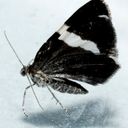Larentiinae
Larentiinae
Classification
- Phylum: Arthropoda
- Subphylum: Hexapoda
- Class: Insecta
- Order: Lepidoptera
- Superfamily: Geometroidea
- Family: Geometridae
- Subfamily: Larentiinae
Pronunciation
How to pronounce Larentiinae: //læˈrɛn.ti.aɪˌniː//
These audio files are automatically generated. While they are not always 100% accurate, they are a good starting point.
Images






Summary
Larentiinae is a diverse subfamily of moths within the Geometridae, recognized for its ancient lineage and distinctive morphological traits, with a rich diversity primarily in temperate regions.
Physical Characteristics
Larentiinae moths typically have longer foreleg tarsi and hindleg tibiae. Their caterpillars often exhibit reduced abdominal prolegs, characteristic of more advanced geometer moths. The tympanal organs have a unique and characteristic structure. They may feature hairy or toothed extensions on the upperside sections of the transtilla.
Identification Tips
Look for the longer foreleg tarsi and hindleg tibiae characteristic of Larentiinae. Also, examine the tympanal organ structure, which is distinct within this subfamily.
Habitat
Larentiinae are found mostly in temperate regions of the world, inhabiting various environments typical for moths.
Distribution
Approximately 5,800 species of Larentiinae are distributed primarily in temperate regions globally.
Diet
Larentiinae caterpillars are herbivorous and often feed on a variety of host plants, typical for the larvae of many moth species.
Life Cycle
Life cycle details include a complete metamorphosis with distinct egg, larval (caterpillar), pupal (chrysalis), and adult stages.
Reproduction
Reproductive habits include oviposition on host plants, where the larvae can feed once they hatch.
Predators
As moths, Larentiinae are preyed upon by various birds, mammals, and other predators in their ecological niches.
Ecosystem Role
Larentiinae play a significant role in their ecosystems as herbivores in the larval stage and as prey for various predators in their adult form.
Collecting Methods
- Light trapping
- Netting adults during flight
- Search and collect caterpillars from host plants
Preservation Methods
- Pinning
- Drying specimens
- Using ethanol for softer-bodied species
Evolution
Larentiinae are suggested to be an ancient lineage within the geometer moth family, indicating a long evolutionary history.
Similar Taxa
Misconceptions
Some may confuse Larentiinae with other moth subfamilies due to overlapping characteristics, especially with more advanced geometer moths.
Tags
- Lepidoptera
- Moths
- Geometridae
- Larentiinae
- Insects